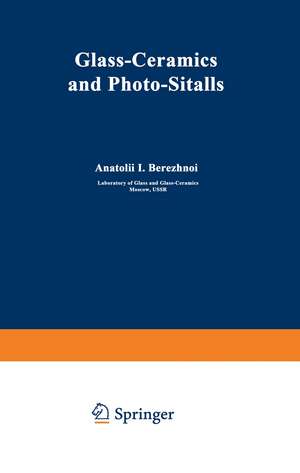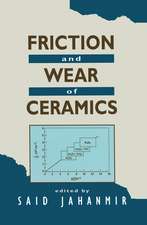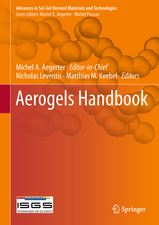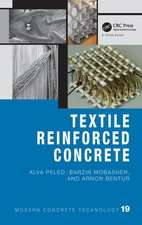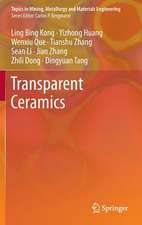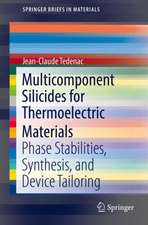Glass-Ceramics and Photo-Sitalls
Autor A. I. Berezhnoien Limba Engleză Paperback – 17 mar 2012
Preț: 397.97 lei
Nou
Puncte Express: 597
Preț estimativ în valută:
76.15€ • 79.87$ • 63.39£
76.15€ • 79.87$ • 63.39£
Carte tipărită la comandă
Livrare economică 01-15 aprilie
Preluare comenzi: 021 569.72.76
Specificații
ISBN-13: 9781468417630
ISBN-10: 1468417630
Pagini: 468
Ilustrații: XX, 444 p.
Dimensiuni: 155 x 235 x 25 mm
Greutate: 0.65 kg
Ediția:1970
Editura: Springer Us
Colecția Springer
Locul publicării:New York, NY, United States
ISBN-10: 1468417630
Pagini: 468
Ilustrații: XX, 444 p.
Dimensiuni: 155 x 235 x 25 mm
Greutate: 0.65 kg
Ediția:1970
Editura: Springer Us
Colecția Springer
Locul publicării:New York, NY, United States
Public țintă
ResearchCuprins
I. Photosensitive Glasses.- 1. General Considerations.- 2. Compositional Characteristics of Photosensitive Glasses.- 3. The Photographic Process.- 4. The Latent Image and Its Properties.- 5. The Developed Image.- 6. Photosensitive Opaline Glasses.- 7. Theory of the Photosensitive Process.- 8. Irradiation of Photosensitive Glasses at High Temperatures.- II. The Formation of Nuclei and the Crystallization of Glass.- 1. Homogeneous, or Spontaneous, Crystallization.- 2. Heterogeneous, or Catalyzed, Crystallization.- 3. Two-Phase Separation and Catalyzed Crystallization of Glass during the Preparation of Glass-Ceramics.- 4. Mechanism of the Action by TiO2 during Catalyzed Crystallization of Titanium-Containing Glasses.- 5. Immiscibility and Crystallization in Glasses Containing Small Amounts of Platinum or Platinum-Group Metals.- 6. Formation of Nuclei and Growth of Colloidal Particles in Photosensitive Glasses.- 7. Critical Size of Stable Nuclei for Heterogeneous Crystallization.- 8. Effect of the Catalyst on the Composition of Precipitating Crystals. Number and Size of the Crystals.- III. Production Technology and Chemical Compositions for Photosensitive Glasses and Photosensitive Glass-Ceramics.- 1. Copper-Containing Photosensitive Glasses.- 2. Gold-Containing Photosensitive Glasses.- 3. Palladium-Containing Photosensitive Glasses.- 4. Silver-Containing Photosensitive Glasses.- 5. Production Technology of the Photosensitive Glass “Fotoform”.- 6. Production Technology and Some Chemical Compositions for Photosensitive Glass-Ceramics.- 7. Metal-Coating of Articles Made from Photosensitive Glass-Ceramics.- IV. Chemical Compositions and Production Technology of Glass-Ceramics.- 1. Glass-Ceramics in the Li2O—Al2O3—SiO2 and MgO—Al2O3—SiO2 Systems with Ti02 Additions,Characterized by a Low Linear Thermal Expansion Coefficient.- 2. Glass-Ceramics in the RO—Al2O3—SiO2 System (Where RO is CaO, ZnO, CdO, BaO, PbO, MnO, FeO, or CoO) with TiO2 or ZrO2 Additions. Glass-Ceramics Transparent to Infrared Radiation.- 3. Glass-Ceramics in the CaO—A12O3—P2O5— SiO2 System and in Other Systems with P2O5 Additions, Having the Properties of English Hard Porcelain.- 4. Glass-Ceramics in the PbO—ZnO—B2O3—SiO2 System. Crystallizing Solder (Sealing) Glasses.- 5. High-Silica Glass-Ceramics in the SiO2—Na2O—K2O System with Fluorine Additions, Characterized by a High Linear Thermal Expansion Coefficient.- 6. Glass-Ceramics with a High Nb2O5 Content, Characterized by a High Dielectric Permeability. Glass-Ceramics Based on Nonsilicate Glasses.- 7. Glass-Ceramics Close in Composition to Synthetic Micas (Mica Glass-Ceramics). Romanian Porcelain Made from Glass.- 8. Glass-Ceramics in the Na2O—A12O3—SiO2 System with ? ? 60–120 · 10-7 (°C)-1. Glass-Ceramics Based on Rocks.- 9. Glass-Ceramics Based on Blast-Furnace Slags (Slag Glass-Ceramics), Characterized by High Wear Resistance and Good Chemical Stability.- 10. Colored Glass-Ceramics.- 11. Production Technology of Glass-Ceramics.- V. Properties of Glass-Ceramics, Photosensitive Glasses, and Photosensitive Glass-Ceramics.- 1. Microstructure.- 2. Physical Properties.- 3. Mechanical Properties.- 4. Thermal Properties.- 5. Electrical Properties.- 6. Chemical Properties.- 7. Optical Properties. Transparent Glass-Ceramics.- VI. Areas of Application of Photosensitive Glasses, Glass-Ceramics, and Photosensitive Glass-Ceramics.- 1. Photosensitive Glasses in Science and Technology and in Construction.- 2. Photosensitive, Reversibly Darkening Photo-chromic Glasses.- 3. PhotosensitiveGlass-Ceramics Articles Used in Electronics.- 4. Nose Cones and/or Shields for Guided Missiles.- 5. Glass-Crystalline Cements in Vacuum Technology.- 6. Glass-Ceramic Envelopes for Vacuum Electronic Apparatus Operating at High Temperatures.- 7. Glass-Ceramics in Machine-Building.- 8. Glass-Ceramic Piping and Tubing for the Chemical and Petroleum-Refining Industries.- 9. Glass-Ceramics for Construction and Common Daily Use.- 10. Other Areas of Application for Glass-Ceramics.- 11. Cost of Glass-Ceramics.- Literature Cited.
